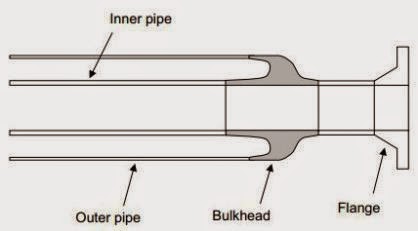Pipe in pipe is another insulation method which an inner
pipe is covered by a larger outer pipe. The annuals between inner pipe an the
outer are filled with insulation materials such as micro-porous silica
(aerogel), polyurethane foam (PUF), wacker, mineral wool, etc.
 |
Pipe in pipe section
|
Pipe in pipe is another insulation method which an inner
pipe is covered by a larger outer pipe. The annuals between inner pipe an the
outer are filled with insulation materials such as micro-porous silica
(aerogel), polyurethane foam (PUF), wacker, mineral wool, etc.
 |
End Bulkhead
|
Water stops are installed to limit the pipeline length
damaged in the event that the annulus is flooded by pipeline failure or
puncture. Water stops are not design code requirement but they are recommended
for deepwater project whaere recovery of the flooded pipeline is challenging. EPDM
or ethylene propylene diene monomer rubber, viton, and sillicone rubber have
been used for the water stop material. The axial compression for the water stop
is provided by using an interlocking clamp arrangement whic will provide the
radial expansion of the ring against the pipe walls.
 |
Water Stop Seal
|
Centralizers or spacers are polymeric rings clamped on the
inner pipe for reeled PIP to protect insulation’s abrasioan damage during
insertion of the ineer pipe into the outer pipe, to protect insulation’s
crushing due to bending load while reeling, and to protect insulation’s
crushing due to thermal buckling during operation.
Centralizer works as a heat sink due to its high thermal
conductivity. Therefore, reducing the number of centralizers by increasing the
centralizer spacing, or centralizer-less design can reduce both the material
and fabrication/installation costs. You can see the figure below to know the
shape of centralizer.
 |
Centralizer
|
For the reeled PIP, the annulus gap needs to be sufficient
to put insulation material, centralizer, and clearance gap to account for the
weld beads, welding misalignment, pipe manufacturing tolerances, etc. The
annulus gap should be in the range of 30 to 40 mm and the net gap (between
insulation and outer pipe) should be 15 mm or higher. You can see the figure
below to know the what I’ve describe above.
 |
| Reeled PIP with centralizer |
Reference :
Jaeyoung, Lee. Introduction to Offshore Pipelines and
Risers. 2007
Hello, an amazing Information dude. Thanks for sharing this nice information with us. Underwater pipeline repair
ReplyDelete